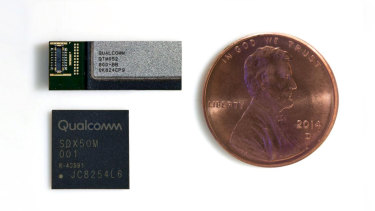Today on smh. If only TLS could advertise their 2gbps 4gx
https://www.smh.com.au/technology/why-you-should-not-buy-a-5g-phone-in-2019-20190206-p50vy4.htmlWhy you should not buy a 5G phone in 2019
Smartphone makers and network carriers are doing their best to hype up 5G as the next big thing, with the first wave of 5G-enabled smartphones due to hit this year.
5G stands for "fifth generation mobile", and it utilises increased allocation of radio spectrum to deliver faster download speeds, ultra-low latency and more capacity; allowing more people to use higher speeds at the same time, limiting congestion. 5G has enormous implications for driverless cars, smart cities and the industrial sector but it will be hitting smartphones first.
5G smartphones are launching in 2019.CREDIT:SHUTTERSTOCK.COM
Every major handset maker (except Apple) plans to release a 5G-capable smartphone in 2019. However the reality is that 5G hardware is going to be a decidedly first-generation affair, where early adopters of 5G smartphones will have to accept all manner of tradeoffs.
Let's put aside the hype for a moment and look at what a 5G smartphone in 2019 really means for you.
AdvertisementCompromised handsets
5G requires a lot more hardware than 4G, leading to compromises in other areas such as smaller capacity batteries and thicker handsets.
Space is at a premium inside a smartphone where every nanometre counts. Chipmaker Qualcomm powers almost every Android smartphone today because it was the first to combine an SoC (system on a chip) with a 4G modem into a single chip. This single-chip solution results in power savings as it takes less to power one chip than two and, more crucially, frees up space for more battery.
Qualcomm's flagship SoC for 2019, the Snapdragon 855, won't have a 5G modem onboard. Instead 5G phones will need a separate modem in addition to at least three RF antenna modules, all of which is going to occupy a lot of space inside a smartphone and tax the battery that much more.
A Qualcomm 5G modem (lower). This would need to be used in conjunction with at least three RF modules (upper) to connect to 5G networks. US penny (about the size of a five cent coin) for scale.
Compare this to a 4G phone which only requires the SoC and it's easy to see why a 4G version of the same phone will have longer battery life and a thinner frame than a 5G model.
5G fragmentation
There are two types of 5G networks: sub-6GHz and millimetre wave (mmWave). The Australian 5G rollout will be using sub-6GHz before mmWave eventually comes online in 2021. Sub-6GHz offers slower speeds in exchange for wider coverage, whereas mmWave brings to the table significantly faster speeds but its range is short and its signal can easily be obstructed.
The problem is that 5G handsets sold in Australia in 2019 will only support the sub-6GHz flavour of 5G, and will be unable to utilise faster 5G connections delivered by mmWave when it is available. Similarly you won't be able to connect to a local carrier's 5G network like you can with 4G when travelling abroad, since countries including the United States use the mmWave standard.
The 5G tax
A 5G smartphone requires pricey new components before it can connect to a 5G network, and you can expect manufacturers to pass that cost on to the consumer.
Many manufacturers and carriers have been cagey about disclosing the 5G mark-up that consumers can expect to pay, but Chinese upstart OnePlus has been more transparent. The company's CEO, Pete Lau, conceded in a recent interview that the 5G model of the upcoming OnePlus 7 will cost "$US200 to $US300 more'"than the 4G version. Expect the 5G tax from more premium brands to be within the same ballpark.
That's a hefty premium to pay for a phone that will likely have less battery life and a larger footprint than a 4G phone.
5G v 4G speeds
5G is primarily being sold to consumers on the promise of delivering blazingly fast network speeds, but in the first few years at least they won't be much faster than existing 4G speeds.
A lot of the hype is being driven by theoretical speeds produced in a lab and not what will actually be achievable in the real world. In theory, 5G networks should be able to handle download speeds of up to 20Gbps. Telcos such as Telstra have achieved speeds of up to 3Gbps in its most recent trial but as is the case with most of the well-publicised 5G trials, they were conducted using mmWave and not the slower sub-6GHz 5G standard that customers in Australia will actually be using.
It's also worth remembering that these speeds will be a lot lower once the signal is divided up among all of the customers in any given area.
For consumers, the 5G specification states that individual users should see a minimum download speed of 100Mbps and upload speeds of 50Mbps, which is what most 5G customers should expect to see in real world day-to-day use, at least until the networks evolve to mmWave.
This means that many people, particularly those who reside in metro areas, are already achieving "5G speeds" with their existing 4G smartphone.
And 4G speeds will only get faster in 2019.
The Snapdragon 855, which will power almost every flagship Android smartphone released this year, contains an onboard 4G modem known as the X24 capable of taking advantage of up to 2Gbps in network speeds. Telstra has enabled peak speeds approaching 2Gbps over its 4G network wherever 5G is available, giving 4G smartphone owners a significant bump up in speeds and one less reason to upgrade to 5G.
- Forums
- ASX - By Stock
- Where to now for long term investors of Telstra
Today on smh. If only TLS could advertise their 2gbps...
-
- There are more pages in this discussion • 386 more messages in this thread...
You’re viewing a single post only. To view the entire thread just sign in or Join Now (FREE)
Add TLS (ASX) to my watchlist
 (20min delay) (20min delay)
|
|||||
|
Last
$3.89 |
Change
0.040(1.04%) |
Mkt cap ! $46.33B | |||
| Open | High | Low | Value | Volume |
| $3.86 | $3.90 | $3.85 | $66.87M | 17.23M |
Buyers (Bids)
| No. | Vol. | Price($) |
|---|---|---|
| 2 | 285738 | $3.88 |
Sellers (Offers)
| Price($) | Vol. | No. |
|---|---|---|
| $3.89 | 133931 | 11 |
View Market Depth
| No. | Vol. | Price($) |
|---|---|---|
| 9 | 444562 | 3.310 |
| 33 | 2195109 | 3.300 |
| 32 | 2624483 | 3.290 |
| 25 | 449073 | 3.280 |
| 15 | 239418 | 3.270 |
| Price($) | Vol. | No. |
|---|---|---|
| 3.320 | 615667 | 9 |
| 3.330 | 2958318 | 59 |
| 3.340 | 1762379 | 73 |
| 3.350 | 2779599 | 159 |
| 3.360 | 300605 | 39 |
| Last trade - 16.10pm 15/11/2024 (20 minute delay) ? |
| TLS (ASX) Chart |













